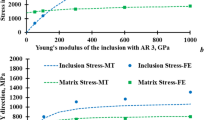Abstract
In this paper, a 3D Superconvergent Patch Recovery (SPR) method is developed for data transferring in elasto-plasticity. The transfer operators are presented for mapping of the state and internal variables between different meshes. In order to transfer the history-dependent variables from old mesh to new one, the internal variables are firstly mapped from the Gauss points to nodal points of old mesh, the variables are then transferred from nodal points of old mesh to nodal points of new mesh, and the values are finally transferred from the nodal points to Gauss points of new mesh. As the solution procedure cannot be re-computed from the initial state, it is continued from the previously computed state. Aspects of the transfer operators are presented in 3D superconvergent patch recovery technique by fitting the best polynomial function with C 0, C 1 and C 2 continuity. Finally, the efficiency of the proposed model and computational algorithms is demonstrated by several numerical examples.
Similar content being viewed by others
References
Zienkiewicz OC and Zhu JZ (1992). The superconvergence patch recovery and a posteriori error estimates, Part I: the recovery techniques. Int J Numer Meth Eng 33: 1331–1364
Zienkiewicz OC and Zhu JZ (1992). The superconvergence patch recovery and a posteriori error estimates, part II: error estimates and adaptivity. Int J Numer Meth Eng 3: 1365–1380
Zienkiewicz OC, Boroomand B and Zhu JZ (1999). Recovery procedures in error estimation and adaptivity, part I: adaptivity in linear problems. Comput Meth Appl Mech Eng 176: 111–115
Boroomand B and Zienkiewicz OC (1999). Recovery procedures in error estimation and adaptivity, part II: adaptivity in nonlinear problems of elasto-plasticity behavior. Comput Meth Appl Mech Eng 176: 127–146
Kitanmra M, Gu H and Nobukawa H (2000). A study of applying the superconvergent patch recovery method in large deformation problem. J Soc Naval Arch Jpn 187: 208–210
Gu H and Kitanmra M (2000). A modified recovery procedure to improve the accuracy of stress at central area of bilinear quadrilateral element. J Soc Naval Arch Jpn 188: 489–496
Gu H, Zong Z and Hung KC (2004). A modified superconvergent patch recovery method and its application to large deformation problems. Finite Elem Anal Des 40: 665–687
Tang X and Sato T (2004). Adaptive mesh refinement and error estimate for 3D seismic analysis of liquefiable soil considering large deformation. J Nat Disaster Sci 26: 37–48
Babuska I and Rheinboldt WC (1978). A-posteriori error estimates for finite element method. Int J Numer Meth Eng 12: 1597–1615
Bank RE and Weiser A (1985). A-posteriori error estimator for elliptic partial differential equations. Math Comput 44: 283–301
Babuska I, Zienkiewicz OC, Gago J and Oliveira ER (1986). Accuracy estimates and adaptive refinements in finite element computations. Wiley, London
Johnson C and Hansbo P (1992). Adaptive finite element methods in computational mechanics. Comput Meth Appl Mech Eng 101: 143–181
Zienkiewicz OC and Taylor RL (2000). The finite element method, vol. 1. McGraw-Hill, New York
Ladeveze E, Cofignal G and Pelle JP (1986). Accuracy of elastoplastic and dynamic analysis. In: Babuska, I (eds) Accuracy estimates and adaptive refinements in finite element computations, pp 181–203. Wiley, London
Samuelsson A, Wiberg NE (1991) Finite element adaptivity in dynamics and elastoplasticity. In: Onate E et al (eds) The finite element method in the 1990’s. Springer, Heidelberg, pp 152–162
Lee NS and Bathe KJ (1994). Error indicators and adaptive remeshing in large deformation finite element analysis. Finite Elem Anal Des 16: 99–139
Babuska I and Strouboulis T (1994). Validation of a posteriori error estimators by numerical approach. Int J Numer Meth Eng 37: 1073–1124
Khoei AR, Tabarraie AR and Gharehbaghi SA (2005). H-adaptive mesh refinement for shear band localization in elasto-plasticity Cosserat continuum. Commun Nonl Sci Numer Simul 10: 253–286
Khoei AR, Gharehbaghi SA, Tabarraie AR and Riahi A (2007). Error estimation, adaptivity and data transfer in enriched plasticity continua to analysis of shear band localization. Appl Math Model 31: 983–1000
Ortiz M and Quigley JJ (1991). Adaptive mesh refinement in strain local ization problems. Comput Meth Appl Mech Eng 90: 781–804
Camacho GT and Ortiz M (1996). Computational modeling of impact damage in brittle materials. Int J Solids Struct 33: 2899–2938
Camacho GT and Ortiz M (1997). Adaptive Lagrangian modeling of ballistic pene tration of metallic targets. Comput Meth Appl Mech Eng 142: 269–301
Peric D, Hochard C, Dutko M and Owen DRJ (1996). Transfer operators for evolving meshes in small strain elasto-plasticity. Comput Meth Appl Mech Eng 137: 331–344
Zlamal M (1978). Superconvergence and reduced integration in the finite element method. Math Comput 32: 663–685
Babuska I, Strouboulis T and Upadhyay CS (1994). A model study of the quality of a posteriori error estimator for linear elliptic problems. Error estimation in the interior of patchwise uniform grids of triangular. Comput Meth Appl Mech Eng 114: 307–378
Babuska I, Strouboulis T, Upadhyay CS and Gangaraj SK (1996). Computer-based proof of the existence of superconvergence points in the finite element method. Superconvergence of the derivatives in finite element solution of Laplace’s Poisson’s and elasticity equations. Numer Meth for PDEs 12: 347–392
Owen DRJ and Hinton E (1980). Finite elements in plasticity: theory and practice. Pineridge Press, Swansea
Author information
Authors and Affiliations
Rights and permissions
About this article
Cite this article
Gharehbaghi, S.A., Khoei, A.R. Three-dimensional superconvergent patch recovery method and its application to data transferring in small-strain plasticity. Comput Mech 41, 293–312 (2008). https://doi.org/10.1007/s00466-007-0186-6
Received:
Accepted:
Published:
Issue Date:
DOI: https://doi.org/10.1007/s00466-007-0186-6




